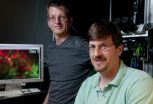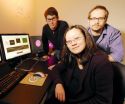(Press-News.org) University of Rochester Medical Center orthopaedic scientists are a step closer to developing a vaccine to prevent life-threatening methicillin-resistant staphylococcus aureus (MRSA) infections following bone and joint surgery.
Other MRSA vaccine research has failed to produce a viable option for patients because of the inability to identify an agent that can break through the deadly bacteria's unique armor. Most other research has targeted the surface of the bacteria, but the URMC team discovered an antibody that reaches beyond the microbe's surface and can stop the MRSA bacteria from growing, at least in mice and in cell cultures.
The Orthopaedic Research Society invited URMC researchers to present their findings on Jan. 16, 2011, at the ORS annual meeting in Long Beach, Calif. The team is led by Edward M. Schwarz, Ph.D., professor of Orthopaedics and associate director of the URMC Center for Musculoskeletal Research. John Varrone, a second-year graduate student in Schwarz's lab, will discuss the data at ORS and the ongoing search for attractive molecular candidates for use in a vaccine.
Staph infection is the leading cause of osteomyelitis, a serious bacterial infection of the bone. Up to half of these infections are due to MRSA, a particular strain of staph known as a "superbug" because of its antibiotic resistance. MRSA causes nearly 500,000 hospitalizations and 19,000 deaths a year in the United States. Although improvements in surgical techniques and use of prophylactic antibiotics prevents some MRSA infections, osteomyelitis is expected to remain a serious problem in the future as people live longer and request more joint replacements and reconstructive surgery.
Management of MRSA infections due to bone and joint surgery is very challenging, Schwarz said, and therefore a vaccine to prevent the infection is badly needed.
It is difficult to pin down the source of most post-surgical MRSA infections, but the health and financial consequences are severe. Hospital stays can last up to six months. Standard treatment includes removing the MRSA-colonized prosthetic joint replacement, then an extensive washing and draining of the infected area in an attempt to clear out all bacteria before it seeds in nearby tissue and bone. Antibiotic spacers are usually placed near the joint for six to eight weeks.
A second joint replacement is an option only if the antibiotic-spacer treatment is successful and the health of the patient remains stable. However, the re-infection rate is very high (40 to 50 percent) and remains a risk for months or even years after the initial assault. In some cases the patient never fully regains the use of the infected joint, said Regis O'Keefe, chief of Orthopaedics at URMC and an expert in the treatment of MRSA.
"It's essential that we have mechanisms in place to prevent this awful infection," O'Keefe said. "We are very excited about our vaccine research. It'll have a phenomenal impact on individuals locally and across the country if we are successful."
Breaking the Zipper
Schwarz, Varrone, and colleagues hypothesized that the best way to attack staph aureus was to target the glucosaminidase (Gmd) protein contained in the deadly bug. Gmd is known to act as a zipper on the bacteria, opening the impenetrable armor (cell wall) during cell division. In the absence of Gmd, staph aureus cannot replicate efficiently, dramatically reducing its ability to cause infections. Thus, if they could find an agent that inhibits bacterial growth and prevents the cell wall from closing during binary fission, Schwarz reasoned, perhaps the bacteria itself could be destroyed.
The abstract presented at ORS describes two key findings. First, the Schwarz lab discovered four anti-Gmd monoclonal antibodies that disrupt the growth of MRSA bacteria in cell cultures, by breaking the zipper and preventing cell division. The team also demonstrated exactly how the antibody works. Since MRSA is inclined to grow rapidly, as single cells, they sought an antigen that forced the bacteria cells to clump. Electron microscopy images of the bacteria exposed to the anti-Gmd antibodies show evidence of exploding staph; however, additional research is being done to confirm this mechanism of action.
Second, researchers demonstrated that when mice were infused with the anti-Gmd antibody, and then exposed to MRSA, only about half of the mice developed the infection. As expected, Schwarz said, protection was dependent upon vaccine dose, with the lowest dose offering the least amount of protection.
"A vaccine in humans would probably not be a foolproof approach to preventing infection 100 percent of the time," Schwarz said. "However, even if we could reduce the risk of MRSA by 35 percent, that would be an enormous improvement in the field."
Researchers are seeking anti-Gmd agents with the best properties for binding to Gmd and making the bacteria less viable. This work is being led by scientists at Codevax LLC, a company started by the University of Rochester and private venture capitalists to co-develop and promote unlicensed vaccine technologies for infectious diseases. John Daiss, a scientist at Codevax, is leading the effort to find existing monoclonal antibodies with strong safety profiles – such as those used to develop the cancer drugs Herceptin and Rituxan – so that researcher can move quickly from the bench to initial clinical trials, Schwarz said.
INFORMATION:
Stephen Dewhurst, Ph.D., chair and dean's professor of Microbiology and Immunology at URMC is president of Codevax. John Daiss is employed by Codevax. Edward Schwarz, John Varrone and Regis O'Keefe do not have a financial interest in the company, however, the University of Rochester holds an equity interest in Codevax.
The MRSA vaccine project is funded, in part, by Codevax. Additional funding was provided by URMC Musculoskeletal Research, URMC Technology Development Grant, and the U.S. Department of Health and Human Services.
Wetter, cooler summers can have a detrimental effect on the milk we drink, according to new research published by Newcastle University.
Researchers found milk collected during a particularly poor UK summer and the following winter had significantly higher saturated fat content and far less beneficial fatty acids than in a more 'normal' year.
But they also discovered that switching to organic milk could help overcome these problems. Organic supermarket milk showed higher levels of nutritionally beneficial fatty acids compared with 'ordinary' milk regardless of the time ...
DETROIT - Shoulder motion after rotator cuff surgery remains significantly different when compared to the patient's opposite shoulder, according to a Henry Ford Hospital study.
In a study that updated prior findings, researchers used X-rays providing a 3D view of motion of the arm bone in relation to the shoulder blade, to compared motion in the shoulders of 22 patients who had arthroscopic surgical repair of tendon tears and no symptoms in their other shoulders. An earlier study looked at 14 patients.
Researchers analyzed the motion of both shoulders at three, 12 and ...
January 16, 2011 – (BRONX, NY) – In a technique that could eventually shed light on how gene expression influences human disease, scientists at Albert Einstein College of Medicine of Yeshiva University have for the first time ever successfully visualized single molecules of naturally-occurring messenger RNA (mRNA) transcribed in living mammalian cells. The scientific achievement is detailed in the January 16 online edition of Nature Methods.
Gene expression involves transcribing a gene's DNA into molecules of mRNA. These molecules then migrate from a cell's nucleus into ...
VIDEO:
Stanford researchers have developed a new technique that allows them to monitor the tiny branches of neurons in a live brain for months at a time. Neuroscientists will now be...
Click here for more information.
Travel just one millimeter inside the brain and you'll be stepping into the dark.
Standard light microscopes don't allow researchers to look into the interior of the living brain, where memories are formed and diseases such as dementia and cancer can take ...
Scientists have identified a protein that acts as a "master switch" in certain white blood cells, determining whether they promote or inhibit inflammation. The study, published in the journal Nature Immunology, could help researchers look for new treatments for diseases such as rheumatoid arthritis that involve excessive inflammation.
Inflammatory responses are an important defence that the body uses against harmful stimuli such as infections or tissue damage, but in many conditions, excessive inflammation can itself harm the body. In rheumatoid arthritis, the joints ...
A pill containing a mix of essential oils has been shown to significantly reduce the symptoms of premenstrual syndrome (PMS). Researchers writing in BioMed Central's open access journal Reproductive Health tested the tablets by carrying out a randomised, controlled trial in 120 women.
Edilberto Rocha Filho worked with a team of researchers from the Federal University of Pernambuco, Brazil, to conduct the tests. He said, "The administration of 1 or 2 grams of essential fatty acids to patients with PMS resulted in a significant decrease in symptom scores. Furthermore, the ...
Does eating a big breakfast help weight loss or is it better to skip breakfast altogether? Available information is confusing but new research published in BioMed Central's open access journal Nutrition Journal clears a path through these apparently contradictory reports.
Dr Volker Schusdziarra, from the Else-Kröner-Fresenius Center of Nutritional Medicine, conducted a study on over 300 people who were asked to keep a journal of what they usually ate. Within the group sometimes people ate a big breakfast, sometimes small, and sometimes skipped it all together.
Schusdziarra ...
Researchers are using inexpensive components from ordinary liquid crystal display (LCD) projectors to control the brain and muscles of tiny organisms, including freely moving worms. Red, green and blue lights from a projector activate light-sensitive microbial proteins that are genetically engineered into the worms, allowing the researchers to switch neurons on and off like light bulbs and turn muscles on and off like engines.
Use of the LCD technology to control small animals advances the field of optogenetics -- a mix of optical and genetic techniques that has given ...
HOUSTON – A small slice of RNA inhibits prostate cancer metastasis by suppressing a surface protein commonly found on prostate cancer stem cells. A research team led by scientists at The University of Texas MD Anderson Cancer Center reported today in an advance online publication at Nature Medicine.
"Our findings are the first to profile a microRNA expression pattern in prostate cancer stem cells and also establish a strong rationale for developing the microRNA miR-34a as a new treatment option for prostate cancer," said senior author Dean Tang, Ph.D., professor in MD ...
"This ebook is for Parents and Educators looking to improve their knowledge of cyber bullying," said Nicole Williams, author of the ebook. It provides valuable information on how cyber bullying can be dealt with and avoided.
Facebook, twitter, and the likes, are changing lifestyles. They have become the community centers for our children. They are the gathering places where 'tween-teens' go to interact and share experiences. This is unlikely to change and in fact will become more prevalent. Learn what you and your children need to be careful of online.
Main points ...



